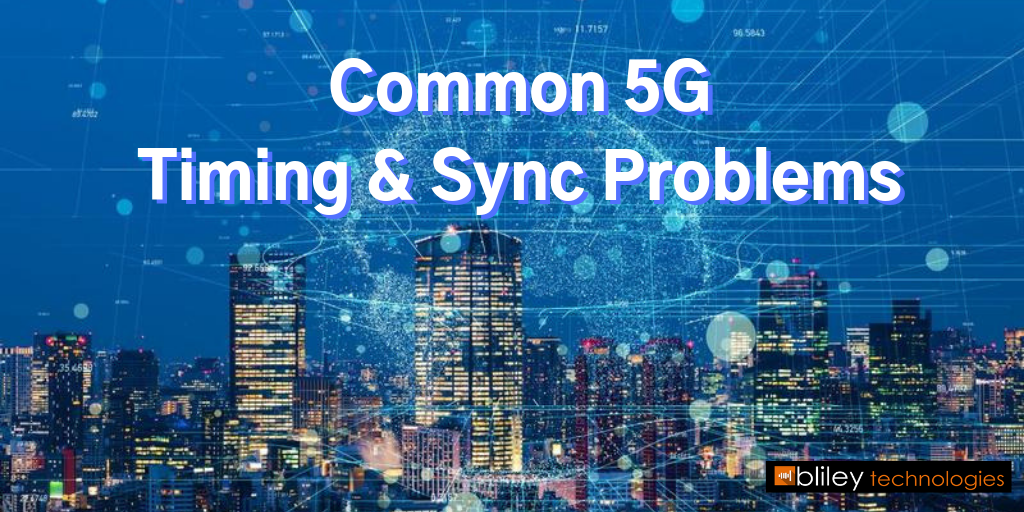
The world is officially hyped to get their hands on new 5G technology. In fact, there was a recent spike in excitement when Verizon announced the release of the first 5G compatible phone, Moto z3.
However, there is still a long way to go until 5G networks are available nationwide. As we get closer to that point, new timing and sync problems are arising.
Let's take a look at some of these foreseen timing challenges that are coming with the implementation of 5G networks. Then, we'll cover some possible solutions to these problems.
The 5G Timing Challenge
The demand for higher bandwidth continues to grow among consumers. Implementing 5G and improving coverage by adding more radio towers (including small cells) will help accomplish this. However, there's a significant trade off and it's kind of ironic...
The ironic problem is that the implementation of 5G and more radio towers will actually work against each other if not synchronized correctly. Poor timing and synchronization within 5G networks may become the new source of customer churn.
Calls will be dropped, videos will be interrupted, and self-driving cars will become self-destructing cars if 5G towers are out-of-sync with each other.
5G Networks vs. Older Generations
Older generation networks (4G, 3G...) only require frequency synchronization to keep signals aligned. However, things are more complicated with 5G.
Not only will frequency synchronization continue to be a concern, but also phase and time requirements. Frequency sync alone will no longer be the primary solution to these new demands.
4 New 5G Bandwidth Problems (and Potential Solutions)
The easiest way for mobile operators to combat the stronger timing and sync requirements could be to simply equip each mobile base station with a GNSS receiver. Then from there, lock into multiple satellite signals to establish precise timing calculations.
Many carriers effectively use this solution today, however there are 2 main concerns here with the implementation of 5G:
1. Many base stations won't have access to multiple satellite signals
Urban areas and cities will require more base stations and antennas to maintain a favorable signal. However, tall buildings, trees, billboards, and other obstacles can easily block satellite signals, especially in more populated areas.
A possible solution could be to place a receiver on a rooftop above surrounding obstacles, but this is not always practical.
This might not seem like a serious issue at first. After all, people will survive if their Stranger Things marathon on Netflix is briefly interrupted...right?
However, throw autonomous vehicles and other critical applications into the equation... and things could get a lot scarier than a Stranger Things episode.
2. Weak GNSS Signals
GNSS Signals are weak at the earth's surface and can easily be interfered with. Common causes of failure could be contributed to
- atmospheric interference
- multi-path from reflected signals
- radiation from malfunctioning electronics
- damages from severe weather
3. Bandwidth Aggregation
Occupying more bandwidth is one of the most critical issues for 5G. To achieve better bandwidth aggregation, a higher precision timing source is required as opposed to just GNSS. More on finding an appropriate 5G timing solution below.
4. Reducing 5G Cell Size
There's been difficulty figuring out the most practical ways to reducing 5G cell size. Successfully reducing cell size will therefore reduce the cell population (and costs).
The Solve-All Solution?
Using a rubidium atomic clock as a go-to timing solution is one of the most common design mistakes. It's simply not a practical solution because of power and holdover stability concerns.
Our Atlas 1PPS GPS Disciplined Oscillator (GPSDO) offers
- Low Phase Noise
- Great short term stability (ADEV)
- Powerful holdover stability (longer term stability)
- Innovative low power technology
- Low profile
- Exceeds long term stability of atomic clocks in many cases
There are other low-cost OCXO solutions like the BOV series that would also be a great solution for 5G network timing and sync at a very low price point.
Installing a high-quality holdover oscillator like Atlas 1PPS at every base station could be a solve-all solution here. The GPSDO capabilities would also allow the oscillator to maintain timing during a GNSS signal outage.
Atlas 1PPS provides atomic clock-like timing accuracy at a fraction of the Size, Weight, Power, and Cost (SWaP-C) for a "Day without Space" scenario... a perfect solution for 5G towers to support expected GNSS outages.
Learn more about Atlas 1PPS timing solutions for 5G networks






